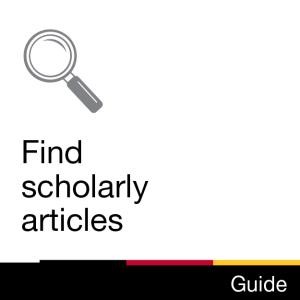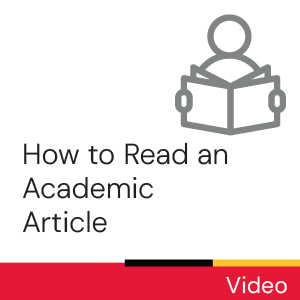Time commitment
Less than 2 minutes
Description
This video will walk you through two criteria for evaluating to identify whether a source is a scholarly journal article.
Video
Transcript
So you've found a source that you want to use for your assignment but you've also been told that you should only use scholarly journal articles.
So how do you know if the source you've found is actually a scholarly journal article?
To find out, answer the following two questions:
Is the source from a peer-reviewed journal? And is it an article?
First, make sure that the journal in which your article is published is peer reviewed. Some search tools offer a one-click option to narrow your search results to those articles classified as peer reviewed.
However, these options are not always accurate.
A more reliable approach involves checking the website for the journal itself. Journals will often identify themselves as peer-reviewed on their site, though sometimes they'll use the word "refereed," which is just another word for peer reviewed.
Start by navigating to the section of the website that describes the journal's mission. This section is often labelled using phrases like "About us," "Aims and Scope," or "Mission statement." Journals will often use these sections to highlight their status as peer reviewed because it brings with it a certain prestige.
For example, the journal Ethnic and Racial Studies describes itself as a publication in which all articles "are peer reviewed to a high standard." The journal may also mention its peer review process in the section of its website that outlines the process for submitting articles for publication.This section is sometimes called "submission guidelines" or "instructions for authors."
Second, make sure that your source is actually an article. In addition to publishing full-length research articles, journals sometimes publish other types of content like book reviews, editorials, and commentary. You may find evidence that what you're looking at is an article in the source itself.
For example, some articles identify themselves as articles in their introductory paragraphs.
Similarly, book reviews and editorials often begin with headings that indicate what type of source they are.
If you're still unsure, check the headings in the table of contents for the issue of the journal in which your source is published.
Let's say you're looking at the source called "From heroes to vulnerable victims" which is published in volume 36, issue 7 of the journal Ethnic and Racial Studies.
To view the table of contents, navigate to the website for the journal, then to the page for the specific issue that contains your source. The table of contents for this issue has the headings "Original Articles" and "Book Reviews."
Our source is found under the heading "Original Articles," which confirms that the source is indeed an article. In sum, if your source is from a peer-reviewed journal and if it's actually an article, chances are your source is a scholarly journal article.
Keep in mind, however, that there's a lot of variation in the ways in which journal content is published, so the methods described in this video may not work in all instances.
If you're still unsure about any of the sources you've found — or you have any questions at all — just ask us.
License

This work is licensed under a Creative Commons Attribution-NonCommercial-ShareAlike 4.0 International License.
Recommended
- Ask Chat is a collaborative service
- Ask Us Online Chat hours
- Contact Us

